
The classification of an inventory product is the primary setting that determines the way the EBMS software handles the specific product. The Classification setting is an important setting that should be configured properly before items are purchased or sold. This section will describe recommended steps to change this important setting in the following scenarios:
Change a product from a classification of No Count to Track Count to manage inventory counts and values in more detail.
Change a product from a classification of Track Count to a classification of Serialized Item or Lots to manage more detail.
Change a kit from a materials list within a sales invoice (classification of No Count) to a manufactured kit (classification of Track Count).
Change a service item that is only sold to a service (classification of No Count) that is purchased from a subcontractor (classification of Track Count).
Click on the hyper-links in the descriptions shown above for more information on specific scenarios.
EBMS contains a report that will list the history of an item's classification
settings. Select the report from the
menu to generate the following
report:

This report will list each time a classification change happens.
Note that any classification that was set with no transactions will not be shown.
Changing the Classification within an existing item is possible but contains various limitations. Attempt to change the Classification in Step #1 shown below and continue with the subsequent steps if the system does not allow you to directly change this setting.
Change the classification: The system will bar the user from completing this step if the product code is listed on any existing order OR if the item contains inventory (Processed inventory s not equal to zero. Continue with step #2 if the system bars the user from completing the #1 Change the Classification step.
The classification can be changed by clicking on the Change button and then selecting
the new Classification from
the drop down list as shown below: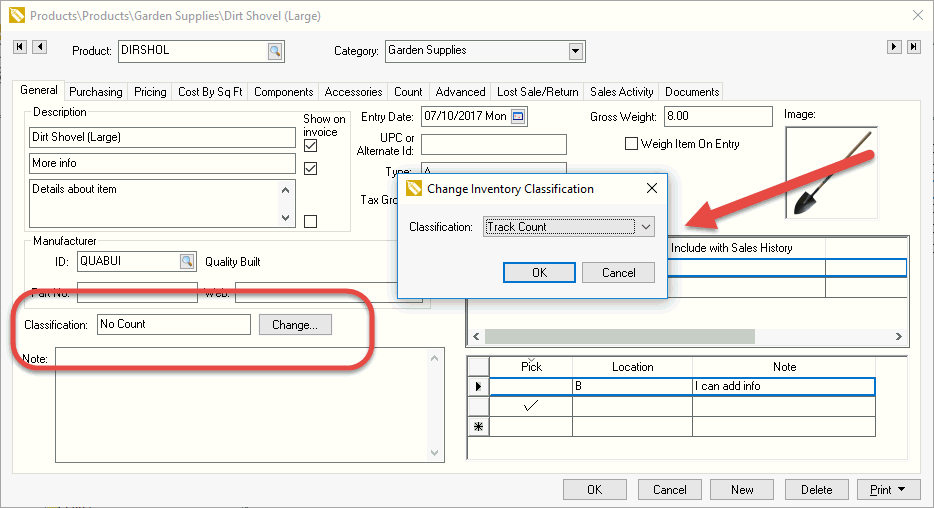
This step completes the process if it is successful. Continue with the next step if the system does not allow the user to change the classification.
Change the original item's part number to another produce code by adding a suffix. This step allows the user to create a new product item with the same Product ID as the original. Complete the following steps to change the Product ID:
Right click on the Product
ID as shown below:

Select Change ID from
the context menu to open the following dialog:
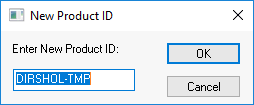
Change the Product ID by adding a suffix such as the employe above: -TMP added to DIRSHOL and click OK.
Create a new product item by duplicating the original inventory item.
Right click on Product
and select Create Duplicate as
shown below :
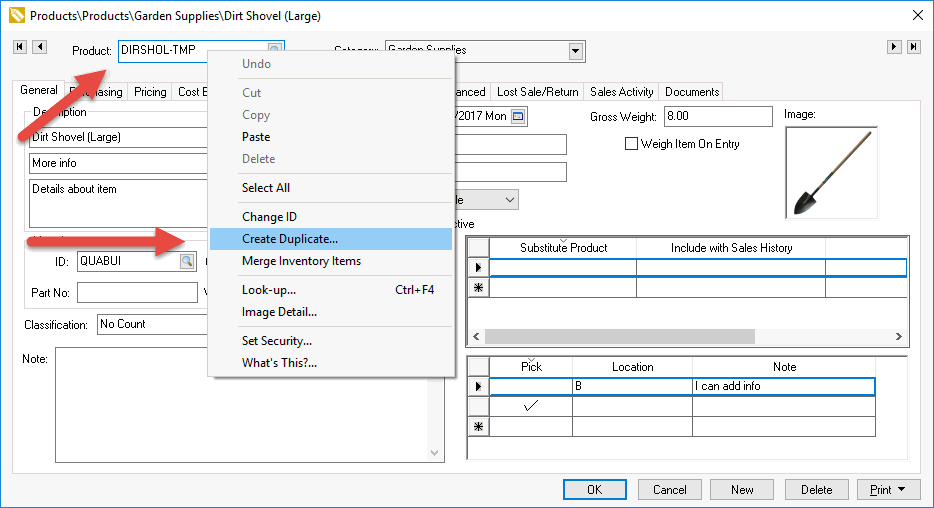
Set new Classification (2nd wizard page) and any other inventory settings that need to be changed from the original. Set the Product ID (last page) to the original code. Review Entering New Inventory Items for details on creating a new product item.
Open the original Product
item (item with suffix) and click on the Cout
tab as shown below and complete the following steps: 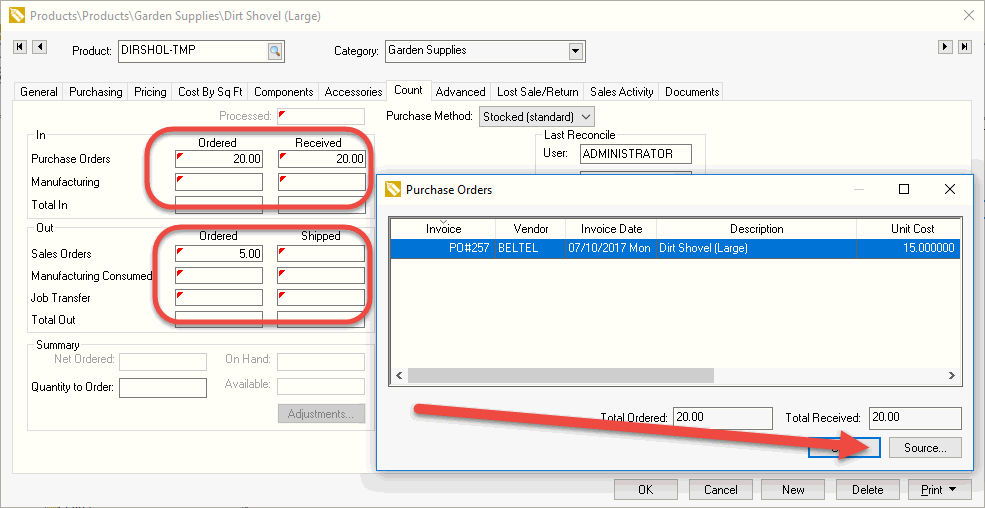
Complete the following steps for every documents that populate
any of the Ordered, Received, or
Shipped values that are circled
above:
Double click on each value to open the corresponding document list: See Purchase Orders dialog shown above:
Open each document listed within the document dialog (Purchase Orders shown above) by double clicking the document or selecting the document and clicking Source.
Change the ID code
within the document to the new product
ID. For example: change DIRSHOL-TMP to
DIRSHOL.
IMPORTANT: Verify that the Description
and the pricing are corrected if they change when the code
is entered.
Save the document. Repeat these steps till all documents are removed from the dialog.
Repeat for each Ordered, Received, or Shipped values that are circled above.
Complete the following steps if
the item has an inventory count value that is NOT equal to zero.
See Processed total
below: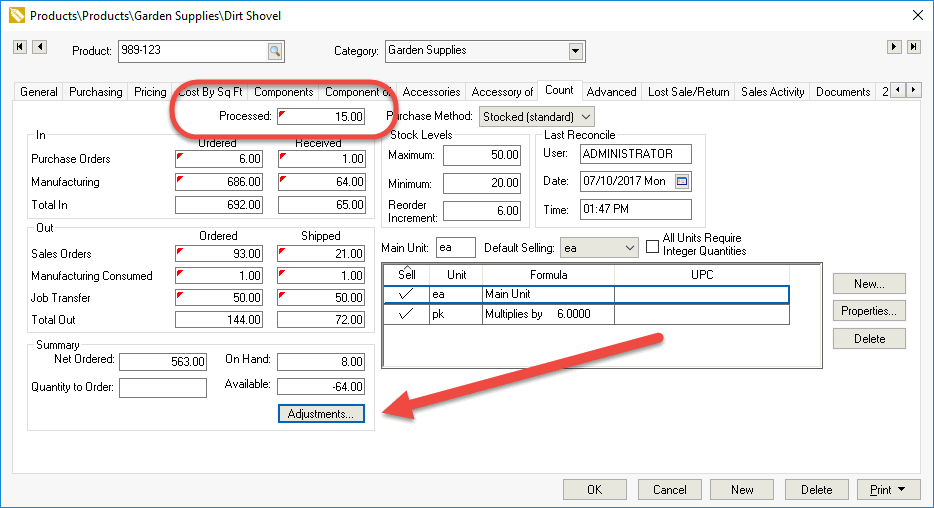
Record the current value of inventory: Print a count
and value report for this item or a folder group of items. Launch
a report by selecting from the main EBMS menu and
selecting to print the following report:
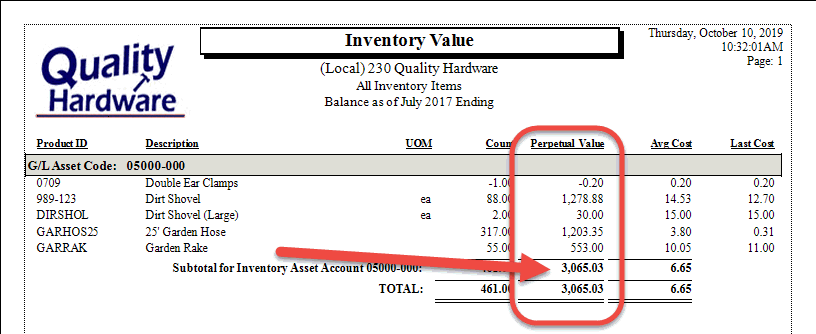
Record the total Perpetual Value for each Inventory Asset Account as marked with the arrow. This total(s) will be used in step # to verify that the inventory value adjustments were correct.
Move inventory counts and values: Adjust both inventory items (both the item with the suffix and the new item):
Decrease the value of the inventory item with the -TMP suffix to zero
Add the same inventory
value (and count if the unit of measure is the same) to the
new item with the same product code.
IMPORTANT: The value that the first item was decreased
must match the value that the 2nd item was increased.
Individual adjustment instructions for the following inventory item classifications:
Repeat these steps for each inventory item within the report printed in step A that requires a classification change.
Generate the value report again the same as step A and compare the individual item values.
Compare the 2nd report total to the original total printed in step A. These totals need to match to maintain inventory value totals.
The last step is to discard the original record that contains a Produce ID with a suffix of -TMP. The following options are important steps to remove this item from the product catalog:
Merge and copy history: This option is recommended if the new inventory item created is the same product as the original item (suffix of -TMP). This option will change and move all sales and purchase history from the original item and move it to the new item. History is important when projecting sales and other features of the purchasing screen and creating inventory stock levels. Complete the following steps to merge an item:
Change the Classification of the original item (item with a suffix of -TMP as described in Step #1 at the beginning of this section.
Right click on the
new Product ID and
select Merge from
the context menu as shown below: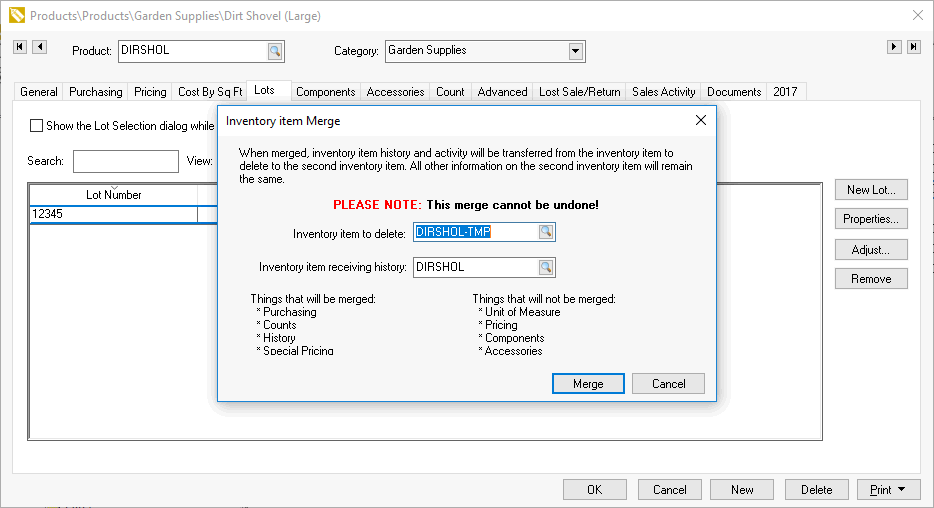
Inactivate and start new item with no history: This option is only recommended when the new item is different than the original item. Example: It is a similar product but different brand, type, or packaged different (different UOM). The history will be of no value if the item is different. Review Product Catalog > Making an Inventory Account Inactive section for details to inactivate an inventory item.
Repeat these steps for all the inventory items that require a classification or other change to the inventory record.
These change classification steps may be helpful to follow in some other scenarios besides the standard classification changes.
An inventory unit of measure change: Review Tracking Counts > Unit of Measure > Changing a Unit of Measure for instructions and issues to consider when changing the UOM.
A substitute or replacement part: Review Substituting an Inventory Item for the recommended steps for new substitute items.
.